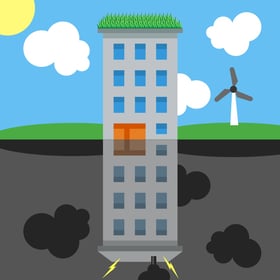How To Make Buildings Sustainable

Sustainability is the topic of the century for professionals of the built environment. The big question is, how are we going to sustain our way of living when we increasingly consume, pollute, and destroy natural resources? As a Facility Manager, you can take an active role in the effort to reduce the consumption of non-renewable resources. You might have heard the term "Net Zero Energy Buildings" or NZEB's. This term means that a building uses as much energy from the grid as it produces onsite through renewables. A net zero energy building is the golden ticket to sustainability. Here are the ways to get there.
1. Energy Conservation
Energy conservation starts with identifying where there is waste. Energy waste is energy consumed when it is not needed or when there are practical energy saving alternatives to inefficient products. For example, it's possible to offer too much lighting to an area for its intended purpose. Over lighting increases the energy demand of a space and may generate complaints by occupants. There are multiple ways to solve this problem:
- Delamping - removing unnecessary bulbs or fixtures
- Lamp Replacement - replacing high output lamps with lower output, lower wattage ones
- Dimmers - controls to manually adjust the light output of fixtures as needed
- Sensored Dimmers - automated controls that adjust light output depending on available ambient light
Small projects like this add up to reduce the overall energy demand of a building making it more sustainable. Some other good ideas for energy conservation include:
- Motion sensors for lighting controls
- Use borrowed light techniques to share artificial or natural light from external spaces with internal spaces
- Regularly clean fixtures and lamps to increase output
- Enable power saving modes on electronic equipment
- Reduce the number of appliances and office equipment
- Lock up thermostats in spaces
- Implement a variable air valve system to properly heat or cool individual spaces
2. Energy Generation
The concept here is a simple one, find any way possible to rely less on the local grid. This means less dependency on utility companies for electricity, gas, or oil. With onsite energy generation there is an opportunity to transcend net zero to become energy independent, essentially the most sustainable a building can get. This means it is able to run solely from its own energy generating sources. This is often only achievable when paired with energy conservation best practices. Here are the most common sources of renewable energy used onsite.
- Solar - used mainly for electrical energy generation using photovoltaic panels but can also be used to pre-heat air and water using infrared absorbing materials
- Wind - used for electrical energy generation
- Geothermal - used mainly for heating and cooling purposes
- Biomass - used mainly for heating
Recently, the city of Chicago pledged to have all of its public buildings running on renewable energy by 2025. This amounts to over 1.8 billion kilowatt-hours. You can read the article here.
3. Water Conservation
Water conservation is important because we rely on it for things taken for granted such as sewer systems, farm irrigation systems, and hydro electric power. Rainfall is not guaranteed, especially in areas prone to drought. To sustain water supplies, building owners and occupants need to find ways use less potable water for purposes other than human consumption. Using less water saves on utility bills and takes away some of the load put on waste water treatment plants which consume energy to purify waste water. Here are a few ways to conserve water in your buildings.
- Rainwater/Stormwater harvesting
- Low flow fixtures
- Motion sensors for fixtures
- Efficient dish and clothes washers
- Change social culture to focus on water conservation
4. Reduce/Optimize Building Footprint
This concept has more to do with space management and looking for ways to make the most of spaces before investing in expansion projects. The more square footage a building has the more costly it will be to heat and maintain. It may also be less expensive to reconfigure current spaces rather than build new ones to accommodate occupant needs.
Ryan Noble
Ryan is Q Ware's Marketing Specialist.